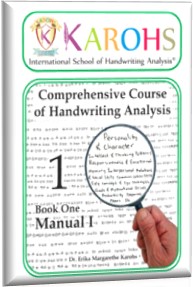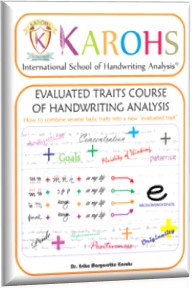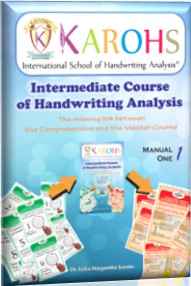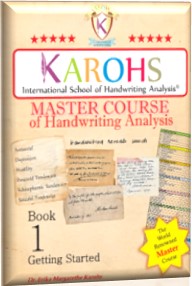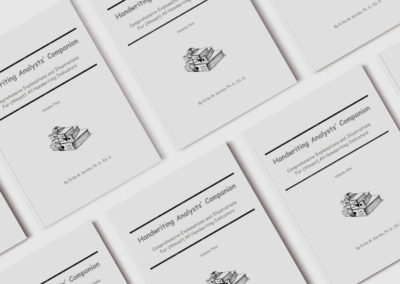Free Article about Handwriting Analysis
From “Sunday Lessons III”
- Sunday Lesson #7: Answers to Quiz from Sunday Lesson #6
By Dr. Erika M. Karohs
Judging by the answers I have received in response to the Quiz in Sunday lesson 6, this is a challenging and interesting assignment. Thanks to those who have participated. I have carefully reviewed each answer and was astounded by the thoroughness of some of them.
The main purpose of this Quiz is to emphasize one of the most important principles in handwriting analysis:
Describe what you see in the handwriting.
Too often, students and analysts know the traits by heart, but when it comes to writing the analysis, they seem stuck and don’t know what to say. The solution to the problem is: Write what you see!.
Being a graphologist is a position of trust. People trust you with their handwritings and expect that you will apply your ethical principles fully to your work. This means – don’t leave out things, and don’t add or manyfacture things that aren’t really in the writing. Describe only what you see.
During my own graphology studies in Germany, our professor has us spent part of nearly every class describing a person according to one handwriting indicators. For instance, how a person would presumable behave with middle zone height extremely small, or copybook, or very large. Then another exercise would be done with middle zone width. Next, we would combine two indicators – small letter height plus broad letter width, or narrow letter width plus large word spacing, etc.
You may want to try this for yourself. It takes much discipline, but it is an invaluable exercise. Suddenly, you will no longer generalize, but describe the person exactly from what you see in the handwriting.
What I have learned during those exercises has stayed with me through the rest of my life and it has improved my analysis writing manyfold.
I realize that this Quiz was difficult because the letters contain traits with which you may not be familiar. Still, it is valuable because you are learning much new information – and you never know when you may encounter these traits in a client’s handwriting yourself!
The interpretations for the letters #3 and #4 will be published with Sunday Lesson #8. At that time, you will also learn who the Winner is. I am really enjoying your contributions.
Answers:
Note: It is very important that you use a magnifying glass to clearly see all the components of these letters.
These are the four letters to be analyzed:
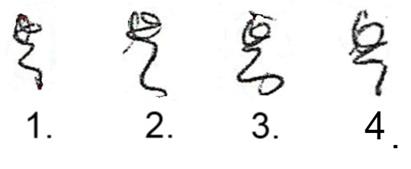
- Letter # 1
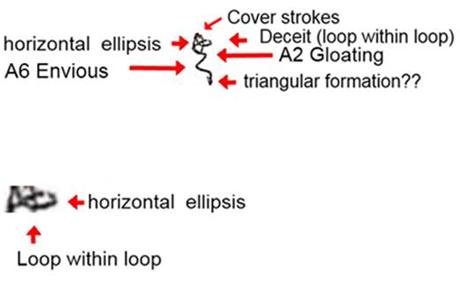
INTERPRETATION OF LETTER #1
- “Letters written as other letters”
The overall form of letter #1 is ambiguous. Out of context, with a good deal of imagination, it might be a Greek “ε..” “Letters written as other letters” (as it is called in graphology) are always negative.
The writer is too defensive to share his honest reactions. He is distrustful of others and does not want to “put his cards on the table,” so to speak. Under no circumstances does he want to be transparent or “readable” to his fellow men. He is afraid of what others would discover if they could “see through him.” The writer manipulates others by intentionally disguising his true intentions. (This indicator is especially serious in combination with threadlike formations.)
- Cover strokes
Looking closely at the oval part of the letter, you will notice that part the oval is retraced or “covers itself” as the writer circles around.
Cover strokes have the effect of hiding a stroke that is already there, such as circling an oval twice or retracing a stroke that already exists. Cover strokes indicate hiding and instinctive evasion.
With cover strokes in ovals the writer displays more than average amounts of defensiveness. Extremely cautious; he tries to conceal things, either through evasiveness or extra secretiveness. He scrutinizes every possible involvement from the aspect of whether or not his security will be improved or threatened by it.
The writer is ultra-conservative due to fear. (Circling around and around means that he is staying “in place,” he is not moving forward.) He is rigid, inflexible, and set in his ways.
- Horizontal ellipses
The horizontal ellipsis** expresses vanity in one of two forms: (1) self-admiration, conceit or (2) excessive pride in one’s possession, appearance, dress, home, etc. With (1), the ellipsis is smoother, more tasteful, more pleasing, whereas with (2), the ellipsis is coarser, more uneven, and less pleasing to the eye.
Important: This applies only to horizontal ellipses, diagonal ellipses have a different interpretation.
- Deceit (loop within loop)
Ovals are communication letters. Clear and unembellished ovals indicate open and frank communication. The more convoluted the ovals are, the more deceitful is the writer.
In letter #1, the oval contains not only the horizontal ellipsis, but in addition, the ellipsis displays a loop within a loop. The writer is intentionally dishonest. His communications should be taken with a grain of salt.
- A2 Gloating and enjoying others misfortunes
Acute angles* have all negative interpretations.
The acute angle #A2 exposes a writer who suffers from unconscious hostility, intensified by personal fear, uncertainty, or lack of confidence. He resents others who are more popular, or more productive, or more gifted than he, himself, is. He is jealous of certain characteristics others may have. When misfortune befalls one of the people he envies, he revels in malevolent delight and gloats with malicious pleasure.
- A6 Envious and begrudging
The acute angle A6* exposes a writer who suffers from unconscious hostility. This is usually caused by a feeling of deprivation intensified by fear, uncertainty, or lack of confidence.
The writer begrudges others the advantages he desires for himself and he is envious of those who seem to get all the breaks. He is jealous of certain characteristics others may have.
The coveted items may not necessarily be beneficial to the writer, but he has deceived himself into believing that they are actually desirable ones. Often, it is not the envy of something special but a very general jealousy of everyone who is more assured, more cheerful, more successful, more poised, or more secure.
The writer feels not only the need to own what others have; he has a strong need to deprive others. He begrudges them their possessions or qualities, even if he does not want them at all. Toward friends and children, the exploiting tendencies are often justified by alleging that they have obligations toward him.
The fallacy is that even when he gets what he wants he cannot enjoy it.
- Triangular formation (illegible)
Under a magnifying glass, the final part of the downstroke of letter #1 looks somewhat like a triangular formation, but it is not clear enough to be interpreted. Therefore, it has to be classified as illegible writing.
Illegible writing can have three reasons:
- The writer simply does not care whether or not he is understood and has little desire to communicate.
His writing will often be original. “Such writers will not compromise with the world at the cost of their originality, they are not interested in popularity; they are not in agreement with or even hostile to the ‘demands of the day’.” Often, they are helpless in every-day affairs, withdrawn and obstinate. They may show neglect of their outward appearance or unusual, even uncouth, behavior. - The writers deliberately try to obscure their writing.
They feel superior to others and consequently feel that they have to make no effort to communicate. They assume in their patronizing way that their thinking is so far beyond others that will not be understood anyway. They usually devise highly individualized letter forms or “symbols” that are meaningful only to them to prove their exclusiveness.
- The writer is concentrating so intensely upon the subject he is writing about that legibility suffers.
Such writings are legible at the beginning but become increasingly illegible as the individual becomes more involved.
INTERPRETATION OF LETTER #2
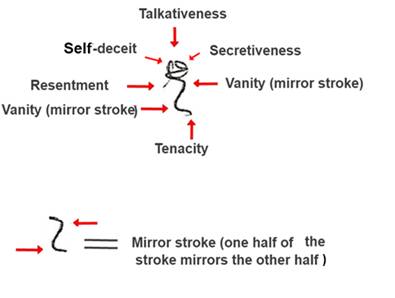
- Talkativeness
Talkativeness is shown by the open oval.
The writer talks automatically. He expresses his ideas, thoughts and opinions impulsively, regardless of whether others want to hear them or not. He blurts out what first comes into his mind without considered judgment, most of the time.
Where it is important to express immediately a first response, he works to advantage. But where a considered response is required, he is a liability. He is not likely to take the time for second thought. And too often, he speaks so quickly that he finds himself committed to something he did not really want to do.
The writer talks so much, most of the time, that he rarely hears what others are saying. He talks his head off and monopolizes other people’s time. Often, his talking comes to no point, it is random; he seems to be talking just to be talking. Because of this, he often misrepresents himself, he blunders verbally. He “runs off at the mouth”, he interrupts and is a poor listener. He cannot hear what others are saying because he is talking himself, or just waiting until he can say what he wants to. He may talk to hear the sound of his own voice. He will be chatting to strangers, too.
The writer’s true intents and desires are usually buried under a rush of irresponsible words. But other people are likely to assume that he means what he says, and he will suffer the consequences. They judge him according to his impetuous speech and treat him accordingly.
In relationships, the trait can cause much harm because it permits many unkind things to be said by people who basically like each other. It does not matter how sorry they are later, a hasty blunder of speech or a quick condemnation of a loved one will cause damage that will take a lot longer to repair than it did to destroy.
The writer functions best where his life or livelihood depends upon his speed of verbal expression. Talkativeness can be an asset in the field of verbal communication. Entertainment, law, high pressure selling and education are vocations in which fluency of speech is needed.
- Secretiveness
Secretiveness is seen in the loop on the right side of the oval.
Secretiveness is a defense trait. The writer conceals personal problems without resorting to deception or misrepresentation of facts.
The writer consciously conceals whatever he chooses not to reveal. In personal relationships, he appears reserved and uncommunicative. When others are revealing their secrets in an affable exchange of confidences, he stays silent. Openness is not his style. He tends to tell people only what he wants them to know and he needs much coaxing to speak of matters of personal concern. He feels threatened by overt communication and most often keeps his thoughts and feelings within. He does not like to discuss his private life and guards his inner feelings carefully from prying eyes.
The writer’s communication with others is composed mostly of agreements or silence. He is more inclined to listen to what other people are saying than to speak himself. He appreciates when others take the lead in the conversation.
It is difficult for the writer to come right to the point. Instead, he starts speaking around what he really wants to say. He is more likely to write his most personal thoughts than to express them verbally. (He is more likely to communicate through texting than by phone.) He is hesitant to disagree because he is afraid of losing friends. As a result, something unspoken frequently stands between him and those close to him.
- Talkativeness plus Secretiveness
These are conflicting traits shown in the same letter. They indicate that the writer may want to keep confidential matters secret, but they tend to slip away from him anyway. He should not be entrusted with confidential information.
- Self-deceit
Self-deceit in letter #1 is seen in the initial loop of the oval.
The writer rationalizes. He refuses to recognize unpleasant facts by denying their existence. He seems to wear blinders and ear plugs to shut out anything he does not want to believe. Self-deceit colors his judgment and he sees situations, especially adverse ones, as he would like them to be. Very often he is unable to admit the truth about himself. Even in the best of times, he refuses to see the world as it really is. He is an escapist who deceives himself about the seriousness of a situation rather than face the truth.
The writer builds false images by facing only parts of a difficulty or situation. He weaves his own interpretations and expects reality to conform. Lacking in mature judgment, he is incapable to deal effectively with reality. His own faulty judgment can be seen as the cause of many of his troubles and his problems may be largely due to the lies he tells himself.
Subconsciously, however, he knows that his reasoning is specious and disappointment is inevitable. He is not only deluding himself, eventually he may be thought of deceptive or devious by others.
- Resentment
Resentment in letter #1 is seen in the initial stroke moving up from below the baseline. Since the stroke is slightly curved, this lessens the intensity of the trait. The writer will put up with a certain amount of imposition before becoming offended.
The writer is emotionally immature and inclined to become indignant toward others, from a sense of being injured or offended. He resents the real or imagined encroachment upon his time, his possessions or his privacy.
He has been taken advantage of in the past by others and consequently, is in a state of preparedness against further imposition. Whether such an alleged intrusion may be real or imagined, his reaction will be the same.
- Vanity in mirror strokes
Parallel or mirror strokes were discovered by Magdalene Ivanovic. They are strokes or letter formations written in a way as if they were mirror images of each other.
Parallel (mirror) strokes express self-love, vanity and a “kind of reflective attitude.” The writer relives an incident in his imagination and reflects upon his own greatness in a self-satisfied way. These formations are often found in inferior handwritings. “As the empty pipe is filled by the wind, the empty head is full of vanity,” says Ivanovic. She adds derisively that “every human being possesses as much conceit as he lacks brain and intellect.”
With smoother, more harmonious parallel strokes, the writer’s vanity pertains to his outer appearance; including his apparel. Less pleasing formations, on the other hand, reveal negative character attributes such as conceit, arrogance, excessive pride and immodesty.
Where parallel strokes are part of the basic letter form rather than an additional adornment, vanity has become an intrinsic part of the writer’s character which will be nearly impossible to eradicate.
Carl Junge, a German graphologist, claims that the “conceit of very vain clergy men is often noticeable only in parallel strokes because in real life it remains hidden behind a façade of sham humility.”
- Tenacity
Tenacity is indicated by final hooks which are basically left tending. They are so-called “back-to-self” strokes and expose self-protective tendencies. They also imply clinging to the familiar and self-interest. Most frequently, the writer’s tenacity is detrimental to his environment. He literally “hooks into” a matter or circumstance for egotistical reasons. He does not want to let go of something from which he hopes to gain a personal advantage. Egotism hooks, as they were called, were one of the earliest signs identified in graphology. In his major work Système de Graphologie Michon lists hooks as evidence of selfishness. He claims that the thinking of these people is geared strictly toward their own interests. Crépieux-Jamin wrote: “Egotism is a vile but easily recognizable enemy; left tending hooks reveal it every time.”Preyerreminds that at a very early age children impulsively make gestures indicating the desire to have, to seize. This desire is strictly for the satisfaction of their own needs without consideration of others. Only few times will children make gestures indicating giving or offering. Preyer believes that unconscious remnants of these gestures are expressed in hooks in the handwriting of people who have retained the grasping, snatching qualities throughout their lives. “Hooks in handwriting,” he says, “whether small or large, light or heavy, show us that behavior and thinking of the writer are directed toward the satisfaction of his own desires and wishes.” Schneidemühl compares egotism hooks to “grasping movements, to claw-like fingers eager for spoil, pointing toward the writer himself”. He reminds that “in barter egotistical people will typically point toward their own chest while trying to delude the other person that they, themselves, are not likely to benefit in any way.”
The tenacious writer clings to his possessions or that which he has gained. It is never easy for him to let go of anything. He gets a firm grip and you cannot pry him loose. It is his intention to hang on at all costs. He clings to his possessions. He hangs on to what he is doing or trying to do. Once the decision has been made and the job has begun, it is hard to shake him loose. He sticks to anything he starts and finishes what he begins, and he will expect others to do the same thing. He can become furious when he suspects someone is trying to take something from him, either emotionally or tangibly.
With money, the writer is conservative and may be a bit stingy. Security is important to him and he feels less vulnerable with cash in the bank. He knows the peace of mind that security confers, and he aims to get it. Economy is natural for him and he tries hard to save. He does not believe in being lavish nor is he particularly attracted to luxuries. He does not waste money and can account at any time for his resources. Tenacity for the writer can be good or bad, depending on the situation. When he is holding on for the right reasons, this adds to the firmness of his character. On the other hand, if he is tenacious for the wrong reasons, this trait may keep him from being able to shift gears and get back on right track. He does not know when to let go. He continues when things no longer work to his advantage or when others who are important to him refuse to cooperate.
Note:
Information used in the Sunday lesson is from the following sources:
 *Acute angles:
*Acute angles:
Erika M. Karohs: Personality Traits At A Glance, Traits in Handwriting You Should Know, But Probably Don’t.
Information in this book is not available from anywhere else. It has been translated, including the trait names, by Dr. Karohs, and it is copyrighted material. If you come across this information in seminars by one of the major handwriting analysis schools, as I have, and they are touting this material as their discovery, be advised that the information is stolen from me.
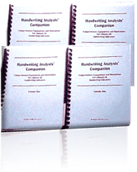 **Horizontal ellipsis
**Horizontal ellipsis
Erika Karohs: Personality Traits At A Glance, Traits in Handwriting You Should Know, But Probably Don’t. Volume 2 (unpublished manuscript – not available yet).
Vanity in mirror strokes:
Erika M. Karohs: “Handwriting Analysts’ Companion (4 volumes).
Trait descriptions:
 “Comprehensive and Illustrated Description for 215 Personality Traits” (6 volumes).
“Comprehensive and Illustrated Description for 215 Personality Traits” (6 volumes).
These books are available at :
I hope you are enjoying this exercise and feel that you are learning from it.
Best regards,
Erika M. Karohs, Ph. D., Ed. D.
I hope you enjoy “Sunday Lessons Series III”. If you have any questions or would like to recommend topics, please feel free to email me at info@karohs.com
See detail courses programs (click the image below):
Handwriting Analysts Companion with 64 page Stroke Master Guide
How many times has it happened to you that you come across a certain handwriting indicator but cannot remember exactly what it means? You know you have read about it, but you just cannot remember where? The 4 volume Handwriting Analysts’ Companion will put an end to this frustration. It lists in alphabetical order comprehensive explanations and illustrations of (almost) all valid handwriting indicators. Of course, by necessity, it cannot cover all interpretations listed in various handwriting analysis manuals. Too many of them are farfetched and unsubstantiated. The companion lists those items generally accepted in the field of graphology as having been researched through experimentally verified observations.
Info : 4 Volumes; Total 601 Pages Price : $ 97
HOME
Click here to back to KAROHS Home Page
COURSE
Click here to see our Course Programs
BOOKS
Click here to see our Books Store
Copyright © 2018 the KAROHS International School of Handwriting Analysis®. All rights reserved.
No image or portion of this website may be copied or reproduced without written permission.



